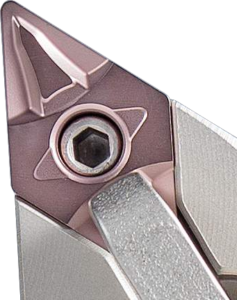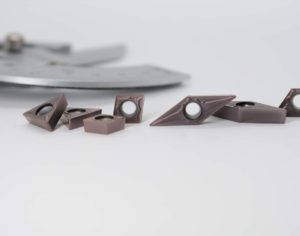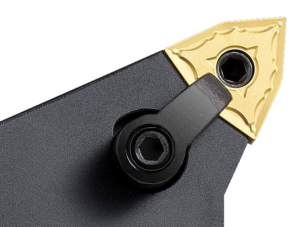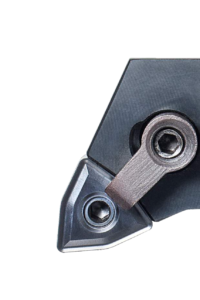1
- On the cutting temperature: cutting speed, feed rate, back to eat the amount of knife;
- The impact of cutting force: back to eat the amount of knife, feed rate, cutting speed;
- The impact on tool durability: cutting speed, feed rate, back to eat knife./n/n

2
- When the amount of knife back to eat doubled, cutting force doubled;
- When the feed rate doubles, the cutting force increases by about 70%
- When the cutting speed doubles, the cutting force decreases gradually
- That is to say, if G99 is used, the cutting force will not change much as the cutting speed increases.
3
The cutting force and the cutting temperature can be judged according to the situation of iron chip discharging.
4
When the actual value x measured is greater than 0.8, and the drawing diameter Y is greater than the concave arc of the car, the R of a tool with a 52-degree side angle (that is, a tool with a 35-degree side angle of 93 degrees) may be grazed at the starting point.

5
temperature indicated by the color of the Iron Filings:
- White is less than 200 degrees/
- yellow, 220.-240 degrees/dark
- Blue, 290
- Blue 320.-350
- Purple and black over 500 degrees
- red Is over 800 degrees
6
FUNACOMTC generally defaults to the G directive:
- G69: Not Really
- G21: Metric size input
- G25: spindle speed fluctuation detected disconnect
- G80: Fixed Cycle canceled/nG54: Default coordinate system
- G18: ZX Plane Selection/nG96(G97) : Constant line speed control
- G99: per feed
- G40: Tip Compensation Cancelled (G41G42)
- G22: stored stroke detection on
- G67: MACRO MODE call canceled
- G64: Not Really
- G13.1: Polar interpolation canceled

7
The external thread is 1.3P, the internal thread is 1.08P.
8
screw Speed S1200 pitch Factor of safety (generally 0.8) .
9
manual tip R compensation formula: from the bottom to the CAR CHAMFER: Z R * (1-tan A / 2) x r 1-tan A / 2 * Tana from the top to the CAR Chamfer will be changed to add.
10
every 0.05 increase in feed, the speed decreases by 50-80 rpm. This is because reducing the speed means that the tool wear decreases; cutting force increases more slowly, thus making up for the increase in feed to increase the cutting force, temperature increases, and the impact.

11
cutting speed and cutting force on the impact of cutting tools is very important; cutting force is too large to make the main reason for tool collapse. The relation between cutting speed and cutting force: the faster the cutting speed, the more constant the feed, the slower the cutting force decreases, and the faster the cutting speed, the faster the tool will wear, the greater the cutting force and the higher the temperature will be, when the cutting force and internal stress is too large for the blade to bear, it will avalanche knife (of course, there are also temperature changes resulting in stress and hardness, and so on) .
12
CNC lathe processing, the following points should be paid special attention to .
(1) at present, the economic numerical control lathe in our country generally adopts the common three-phase asynchronous motor to realize step-less speed change through the frequency converter. If there is no mechanical deceleration, the spindle output torque is often insufficient at low speed, and if the cutting load is too large, easy to boring, but some machine tools with gear shift very good solution to this problem;
(2) as far as possible so that the tool can complete a part or a work shift of the processing work, especially to pay attention to the finishing of large pieces to avoid mid-change tool to ensure that the tool can complete a processing;
(3) using numerical control turning thread to achieve high quality and high efficiency because of using higher speed as far as possible;
(4) use G96 where possible;
(5) the basic concept of high-speed machining is to feed more than the speed of heat conduction, thus separating the cutting heat from the work piece by removing the cutting heat with the iron chips and ensuring that the work piece does not heat up or does not heat up, high speed machining is to select a high cutting speed and high feed matching at the same time select a small back eat knife;
(6) pay attention to the compensation of the tip.

13
The basic reason for all this is that the cutting force becomes bigger and the rigidity of the tool is not enough, the tool extension length is shorter, the back angle is smaller, the area of the blade is bigger and the rigidity is better, and the bigger the cutting force is, but the larger the width of the slotting tool, the larger the cutting force it can bear, but its cutting force will also increase, on the contrary, the smaller the slotting tool, the smaller the cutting force it can bear, but its cutting force is also small.
14
because OF VIBRATION IN THE TANK:
(1) the overextend length of the cutter leads to the decrease of the rigidity;
(2) if the feed rate is too slow, the unit cutting force will increase, which will cause large vibration. The formula is as follows: PF / Back Feed Force * FP is the Unit Cutting Force F is the cutting force, in addition, if the rotation speed is too fast, the unit cutting force will vibrate;
(3) the machine tool is not rigid enough, that is to say, the cutting tool can bear the cutting force, but the machine tool can not bear the cutting force. To put it bluntly, the machine tool does not move. Generally speaking, the new machine tool will not have this kind of problem. The machine tool that has this kind of problem is either old or old, or He’s been seeing machine-tool killers.

15
when in turning a cargo, initially found that the size is all right, but after doing a few hours found that the size has changed and size instability may be the reason at the beginning because the knives are new, so the cutting force is not very big, but after a period of time after the tool wear, cutting force, leading to the workpiece in the Chuck Displacement, so the size of the old run and unstable.
16
When G71 is used, the values of P and q must not exceed the sequence number of the entire program, or an alarm will be raised: The G71-g73 instruction is not in the correct format, at least in FUANC.

17
subroutines IN FANUC SYSTEMS COME IN TWO FORMATS:
(1) the first three digits of p000000 refer to the number of cycles and the last four digits are the sequence number;
(2) the first four digits of P0000L000 are the program number and the last three digits of l is the number of cycles.
18
of the starting point of the ARC is not changed, and the endpoint Z is offset by a MM, then the position of the bottom diameter of the arc is offset by a / 2.

Leave A Comment